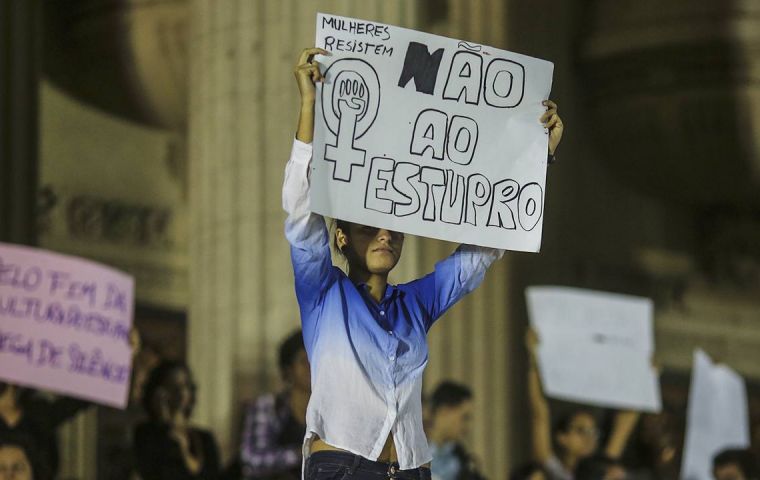MercoPress. South Atlantic News Agency
Brazil: rape cases 7% up in 2022 from previous year
 Only 22.8% of rapes of people over 14 years old were committed by strangers, the report noted
Only 22.8% of rapes of people over 14 years old were committed by strangers, the report noted According to the Brazilian Security Forum, the number of rapes recorded in South America's largest country last year was 8.2% higher than in 2021, it was reported in the Brazilian Public Security Yearbook 2023 launched Thursday. Rape cases totaled 18,110 victims in 2022, an increase of 7% over the previous year, and those of rape of a vulnerable person, 56,820 victims, 8.6% more than in the previous year, the study also showed.
Only 8.5% of rapes in Brazil are reported to the police and 4.2% by health information systems. Thus, according to the estimate, the level of rape cases in Brazil is 822 thousand cases annually.
The survey reveals that children and adolescents remain the biggest victims of sexual violence: 10.4% of rape victims were babies and children up to 4 years old; 17.7% of victims were between 5 and 9 years old and 33.2% were aged between 10 and 13 years old. In other words, 61.4% were at most 13 years old. Around 8 out of 10 victims of sexual violence were minors. Under Brazilian law, a person is only able to consent from the age of 14.
According to the yearbook, last year 88.7% of victims were female and 11.3% male; 56.8% were black or brown (52.2% the previous year); 42.3% were white; 0.5% were indigenous; and 0.4% were yellow.
“Although we do not have research on the subject in Brazil, it is common to hear reports from education professionals, or even police officers, who indicate that it was the teacher who noticed differences in the child's behavior and first learned of the abuse. Thus, the school plays a fundamental role in identifying episodes of violence, but mainly in providing the necessary knowledge so that children understand about sexual abuse and are able to protect themselves,” the yearbook also notes.
The work also points out that it is common for children not to be able to recognize abuse, either due to a lack of knowledge or due to a bond with the aggressor. “It is understandable that the child has some feeling of love or even loyalty for the aggressor since in general the abuse is practiced by parents, stepparents, grandparents, and other relatives. In addition, the abuser tends to manipulate the child with threats or bribes, which ensures the victim's silence. The feeling of guilt or shame is usually present in the child, who ends up not revealing anything to family members.”
According to the records, 82.7% of abusers are known to the victims and 17.3% are unknown. Among children and adolescents aged up to 13 years, the main perpetrators are family members (64.4% of cases), and 21.6% are known to the victim, but not related. Among victims aged 14 and over, 24.4% of the abuses were committed by intimate partners or ex-partners of the victim, 37.9% by family members, and 15% by other acquaintances. Only 22.8% of rapes of people over 14 years old were committed by strangers.
The home is the most frequent location, since on average 68.3% of the combined cases of rape and rape of a vulnerable person occurred in the victim's home. The proportion of rapes of vulnerable persons that occur at home is 71.6% and in rapes, 57.8%. The streets were the place indicated in 17.4% of the rape records and in 6.8% of the vulnerable ones. Most cases of sexual violence (53.3%) occur at night or in the early morning (between 6 pm and 5.59 am). As for the occurrences of rape of a vulnerable person, which mainly affect children, the majority (65.1%) were during the day, between 6 am and 11.59 am, or between noon and 5:59 pm, when the mother or caregiver is usually away.
According to Juliana Brandão, from the Brazilian Public Security Forum, the number of rape cases is the highest since the institution began to monitor such occurrences, and it is difficult to attribute the increase to a single factor, mainly because it is an extremely complex crime, which has its specificities. “In this case, we are talking about children up to 13 years old, considered vulnerable. This increase in numbers is only the increase in notifications because the crime of rape in itself is already a crime that, by its nature, already has a lot of underreporting. When we are looking at this universe more of children and adolescents, it is even more difficult to imagine that children and adolescents were responsible for notifying the great violence they suffered,” she said.
In Brandão's view, it is possible that these figures are the result of a set of factors that can be explained, in part, by the greater empowerment of victims, but there are also some adults “who have managed, in some way, to function by mediating, listening to the report of children and adolescents and taking it to the police so that the record could be made,” she added.
(Source: Agencia Brasil)




Top Comments
Disclaimer & comment rules-

Read all commentsWow ,can't imagine why...?
Jul 22nd, 2023 - 04:58 am 0Commenting for this story is now closed.
If you have a Facebook account, become a fan and comment on our Facebook Page!